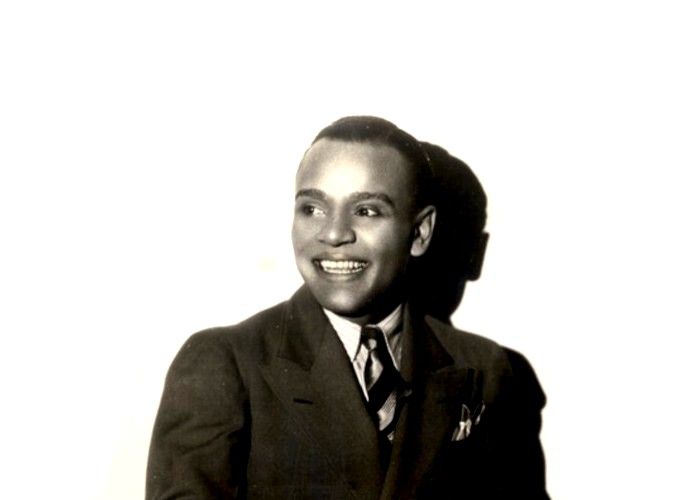 Lucius Venable “Lucky” Millinder, August 8, 1910 – September 28, 1966, was a Harlem rhythm-and-blues and swing bandleader.
Lucius Venable “Lucky” Millinder, August 8, 1910 – September 28, 1966, was a Harlem rhythm-and-blues and swing bandleader.
Although he could not read or write music, did not play an instrument, and rarely sang, his showmanship and musical taste made his bands successful.
His group was said to have been the greatest big band to play rhythm and blues and gave work to a number of musicians who later became influential at the dawn of the rock and roll era.
He was inducted into the Alabama Jazz Hall of Fame in 1986.
Early career
Millinder was born Lucius Venables in Anniston, Alabama. He took the surname Millinder as a child and was raised in Chicago.
In the 1920s he worked in clubs, ballrooms, and theatres in Chicago as a master of ceremonies and dancer. He first fronted a band in 1931 for an RKO theater tour, and in 1932 took over the leadership of Doc Crawford’s orchestra in Harlem. He also freelanced elsewhere.
In 1933, he took a band to Europe, playing residencies in Monte Carlo and Paris. He returned to New York to take over the leadership of the Mills Blue Rhythm Band, which included Henry “Red” Allen, Charlie Shavers, Harry “Sweets” Edison and J. C. Higginbotham, and which had a regular slot at The Cotton Club.
With his own orchestra
In 1938 he teamed up with pianist Bill Doggett to front Doggett’s group. By 1940 had formed a completely new orchestra, which included Doggett and the drummer “Panama” Francis.
Around this time he discovered the established gospel singer and guitarist Rosetta Tharpe, with whom his ensembles performed for many years and first recorded with four cuts for Decca in 1938.
He established a residency at New York’s Savoy Ballroom and won a contract with Decca Records.
Dizzy Gillespie was the band’s trumpeter for a while and was featured on Millinder’s first charting hit, “When the Lights Go On Again (All Over the World)”, which reached number 1 on the R&B chart and number 14 on the pop chart in 1942.
The follow-up records “Apollo Jump” and “Sweet Slumber” were also big hits, with vocals by Trevor Bacon.
By the mid-1940s the band was drifting towards what came to be known as rhythm and blues. Other band members around this time included the saxophonists Bull Moose Jackson, Tab Smith and Eddie “Lockjaw” Davis, and the pianist “Sir” Charles Thompson.
In 1944 Millinder recruited the singer Wynonie Harris, and their recording of “Who Threw the Whiskey in the Well” became the group’s biggest hit in 1945, staying at number 1 on the R&B chart for eight weeks and also reaching number 7 on the US pop chart.
After Harris left for a solo career, Millinder followed up with another hit, “Shorty’s Got to Go“, on which he took lead vocals.
Soon afterward, Ruth Brown became the band’s singer for a short period before her own solo career took off.
Towards the end of WWII and into the post-war period, the economic situation for touring ensembles (including gas-rationing and entertainment taxes) began to favor smaller bands (such as Louis Jordan’s), and limited the number of appearances orchestras such as Millinder’s could command.
In the late 1940s, the band remained popular and toured around all the large R&B auditoriums, although it had few charts hits for several years.
In 1949 the band left Decca Records and joined first RCA Victor and then King Records, recording with the singers Big John Greer and Annisteen Allen.
The band’s last big hit was “I’m Waiting Just for You“, with Allen, in 1951, which reached number 2 on the R&B chart and number 19 on the pop chart. A year earlier, Millinder’s track “Silent George” had become a dirty blues hit.
Later yearsBy 1952, Millinder began working as a radio DJ. He continued touring with his band, but his style was falling out of favor, and the band’s history of many personnel changes began to affect its sound.
In 1954 he took over the leadership of the house band at the Apollo Theater for a while.
Related: In celebration of Jazz Month check out our “HWM Jazz Month 2022” link.
He effectively retired from performing around 1955, although his final recordings were in 1960.
He became active in music publishing and in public relations for a whiskey distillery.
Died
He died of a liver ailment in Harlem, New York in September 1966.
Photo credit: Wikipedia (re-touching Tisdale Studio).
Become a Harlem Insider!
By submitting this form, you are consenting to receive marketing emails from: . You can revoke your consent to receive emails at any time by using the SafeUnsubscribe® link, found at the bottom of every email. Emails are serviced by Constant Contact








